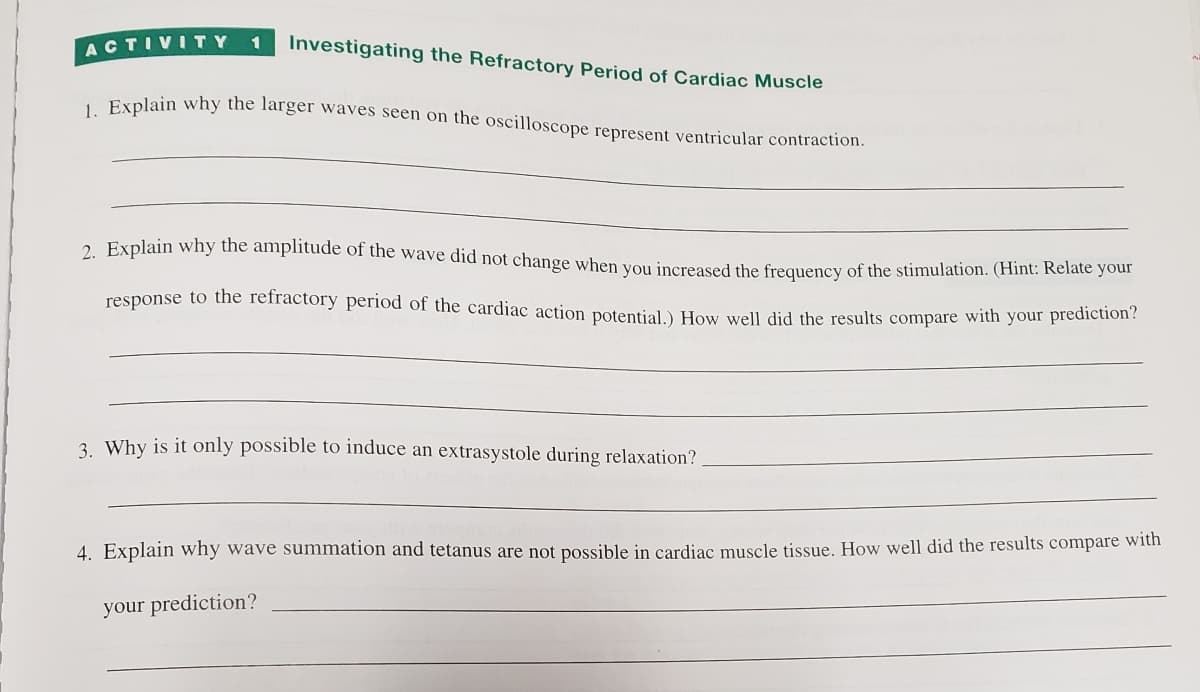1. Explain why the larger waves seen on the oscilloscope represent ventricular contraction. 2. Explain why the amplitude of the wave did not change when you increased the frequency of the stimulation. (Hint: Relate your response to the refractory period of the cardiac action potential.) How well did the results compare with your prediction 3. Why is it only possible to induce an extrasystole during relaxation? 4. Explain why wave summation and tetanus are not possible in cardiac muscle tissue. How well did the results compare your prediction?
1. Explain why the larger waves seen on the oscilloscope represent ventricular contraction. 2. Explain why the amplitude of the wave did not change when you increased the frequency of the stimulation. (Hint: Relate your response to the refractory period of the cardiac action potential.) How well did the results compare with your prediction 3. Why is it only possible to induce an extrasystole during relaxation? 4. Explain why wave summation and tetanus are not possible in cardiac muscle tissue. How well did the results compare your prediction?
Human Anatomy & Physiology (11th Edition)
11th Edition
ISBN:9780134580999
Author:Elaine N. Marieb, Katja N. Hoehn
Publisher:Elaine N. Marieb, Katja N. Hoehn
Chapter1: The Human Body: An Orientation
Section: Chapter Questions
Problem 1RQ: The correct sequence of levels forming the structural hierarchy is A. (a) organ, organ system,...
Related questions
Question

Transcribed Image Text:Investigating the Refractory Period of Cardiac Muscle
1. Explain why the larger waves seen on the oscilloscope represent ventricular contraction.
ACTIVITY
1
2. Explain why the amplitude of the wave did not change when you increased the frequency of the stimulation. (Hint: Relate your
response to the refractory period of the cardiac action potential.) How well did the results compare with your prediction?
3. Why is it only possible to induce an extrasystole during relaxation?
4. Explain why wave summation and tetanus are not possible in cardiac muscle tissue. How well did the results compare with
your prediction?
Expert Solution
This question has been solved!
Explore an expertly crafted, step-by-step solution for a thorough understanding of key concepts.
This is a popular solution!
Trending now
This is a popular solution!
Step by step
Solved in 3 steps

Recommended textbooks for you

Human Anatomy & Physiology (11th Edition)
Anatomy and Physiology
ISBN:
9780134580999
Author:
Elaine N. Marieb, Katja N. Hoehn
Publisher:
PEARSON

Anatomy & Physiology
Anatomy and Physiology
ISBN:
9781259398629
Author:
McKinley, Michael P., O'loughlin, Valerie Dean, Bidle, Theresa Stouter
Publisher:
Mcgraw Hill Education,

Human Anatomy
Anatomy and Physiology
ISBN:
9780135168059
Author:
Marieb, Elaine Nicpon, Brady, Patricia, Mallatt, Jon
Publisher:
Pearson Education, Inc.,

Human Anatomy & Physiology (11th Edition)
Anatomy and Physiology
ISBN:
9780134580999
Author:
Elaine N. Marieb, Katja N. Hoehn
Publisher:
PEARSON

Anatomy & Physiology
Anatomy and Physiology
ISBN:
9781259398629
Author:
McKinley, Michael P., O'loughlin, Valerie Dean, Bidle, Theresa Stouter
Publisher:
Mcgraw Hill Education,

Human Anatomy
Anatomy and Physiology
ISBN:
9780135168059
Author:
Marieb, Elaine Nicpon, Brady, Patricia, Mallatt, Jon
Publisher:
Pearson Education, Inc.,

Anatomy & Physiology: An Integrative Approach
Anatomy and Physiology
ISBN:
9780078024283
Author:
Michael McKinley Dr., Valerie O'Loughlin, Theresa Bidle
Publisher:
McGraw-Hill Education

Human Anatomy & Physiology (Marieb, Human Anatomy…
Anatomy and Physiology
ISBN:
9780321927040
Author:
Elaine N. Marieb, Katja Hoehn
Publisher:
PEARSON